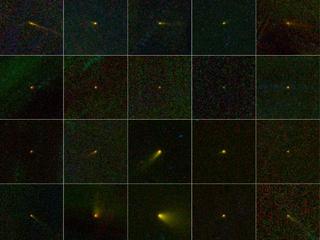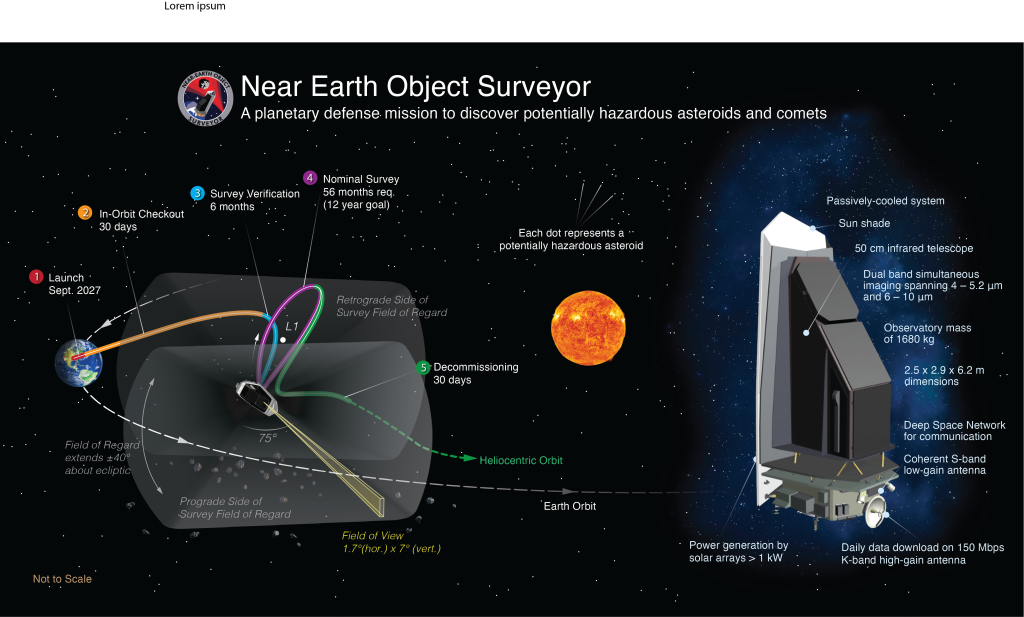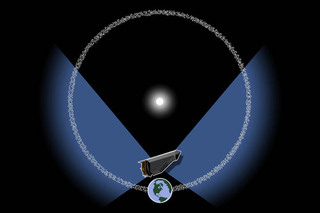Science Publications
NEOCam leverages the experience of the NEOWISE team. See a list of NEOWISE publications.
Mainzer, A., et al. “Survey Simulations of a New Near-Earth Asteroid Detection System” 2015, AJ, accepted.
Girard, J., et al. “Cosmic ray response of megapixel LWIR arrays from TIS” 2014, Proc. SPIE 9154.
McMurtry, C., et al., “Development of sensitive long-wave infrared detector arrays for passively cooled space missions” 2013, Opt. Eng. 52(9).
Bottke, W. F., Vokrouhlický, D., Ballouz, R.-L., Barnouin, O. S., Connolly, H. C., Jr., Elder, C., Marchi, S., McCoy, T. J., Michel, P., Nolan, M. C., Rizk, B., Scheeres, D. J., Schwartz, S. R., Walsh, K. J., Lauretta, D. S. 2020. Interpreting the Cratering Histories of Bennu, Ryugu, and Other Spacecraft-Explored Asteroids (PDF). Astron. J. 160, 14.
Bottke, W. F., A. Moorhead, H. C. Connolly Jr, C. W. Hergenrother, J. L. Molaro, P. Michel, M. C. Nolan, S. R. Schwartz, D. Vokrouhlický, K. J. Walsh, and D. S. Lauretta. 2020. Meteoroid Impacts as a Source of Bennu’s Particle Ejection Events (PDF), JGR-Planets 125, 2019JE006282
Nesvorný, D., Vokrouhlický, D., Bottke, W. F., Levison, H. F., Grundy, W. M. 2020. Very Slow Rotators from Tidally Synchronized Binaries (PDF). Astrophys. J. 893, L16.
Mazrouei, S., R. R. Ghent, W. F. Bottke, A. H. Parker, T. M. Gernon. 2019. Earth and Moon impact flux increased at the end of the Paleozoic (PDF). Science 363, 253-257.
Supplementary Material for Earth and Moon impact flux increased at the end of the Paleozoic (PDF)
Granvik, M., Morbidelli, A., Jedicke, R., Bolin, B., Bottke, W. F., Beshore, E., Vokrouhlicky, D., Nesvorny, D., Michel, P. 2018. Debiased orbit and absolute-magnitude distributions for near-Earth objects (PDF). Icarus 312, 181-207.
Jedicke, R., Bolin, B. T., Bottke, W. F., Chyba, M., Fedorets, G., Granvik, M., Jones, L., Urrutxua, H. 2018. Earth’s Minimoons: Opportunities for Science and Technology (PDF). Frontiers in Astronomy and Space Sciences 5, 13.
Stokes, G. H., B. W. Barbee, W. F. Bottke, M. W. Buie, S. R. Chesley, P. W. Chodas, J. B. Evans, R. E Gold, T. Grav, A. W. Harris, R. Jedicke, A. K. Mainzer, D. L. Mathias, T. B. Spahr, D. K. Yeomans. 2017. Update to determine the feasibility of enhancing the search and characterization of NEOs (PDF). Report of the Near-Earth Object Science Definition Team. Prepared at the request of NASA, Science Mission Directorate, Planetary Science Division.
Granvik, M., Morbidelli, A., Vokrouhlicky, D., Bottke, W. F., Nesvorny, D., Jedicke, R. 2017. Escape of asteroids from the main belt (PDF). Astronomy and Astrophysics 598, A52.
Granvik, M., Morbidelli, A., Jedicke, R., Bolin, B., Bottke, W. F., Beshore, E., Vokrouhlicky, D., Delbo, M., Michel, P. 2016. Super-catastrophic disruption of asteroids at small perihelion distances (PDF). Nature 530, 303-306.
Supplementary Material for Super-catastrophic disruption of asteroids at small perihelion distances (PDF)
Mazanek, D. and 20 colleagues. 2016. Asteroid Redirect Mission (ARM) Formulation Assessment and Support Team (FAST) Final Report (PDF). NASA/TM–2016-219011.
A Family-based Method of Quantifying NEOWISE Diameter Errors
Thermophysical Modeling of NEOWISE Observations of DESTINY+ Targets Phaethon and 2005 UD
Uncertainties on Asteroid Albedos Determined by Thermal Modeling
Dorn, M.;McMurtry, C.; Pipher, J.; Forrest, W.; Cabrero, M.; Wong, A.; Mainzer, A.; Lee, D.; Pan, J. 2018, Proceedings of the SPIE 10709, id. 1070907, “A monolithic 2k × 2k LWIR HgCdTe detector array for passively cooled space missions (PDF)”
Mario S. Cabrera, Craig W. McMurtry, Meghan L. Dorn, William J. Forrest, Judith L. Pipher, Donald Lee, “Development of 13 μm cutoff HgCdTe detector arrays for astronomy (PDF),” JATIS 5(3), 036005 (2019), doi: 10.1117/1.JATIS.5.3.036005
Mario S. Cabrera, Craig W. McMurtry, William J. Forrest, Judith L. Pipher, Meghan L. Dorn, Donald L, JATIS 6(1), 011004 (2020) “Characterization of a 15 μm Cutoff HgCdTe Detector Array for Astronomy (PDF)”
Zengilowski, G.; Cabrera, M.; McMurtry, C., Pipher, J.; Dorn, M.; Reilly, N.; Bovie, D.; Mainzer, A.; Wong, A.; Lee, D. under review JATIS (2021), Blooming in H2RG arrays: Laboratory measurements of a second brighter-fatter type effect in HgCdTe infrared detectors (PDF)
Pipher, J.; McMurtry, C.; Cabrera, M.; Forrest, W. accepted by JAI (2021) Mid-Infrared Detector Array Technologies for SOFIA and Space Observatory Instruments (PDF)
Zengilowski, Gregory R.; McMurtry, Craig W.; Pipher, Judith L.; Reilly, Nicholas S.; Forrest, William J.; Cabrera, Mario S.; Dorn, Meghan L.; Wong, Andre F.; Mainzer, A. K.; “Signal nonlinearity measurements and corrections in MWIR and LWIR HgCdTe H2RG arrays for NEO Surveyor (PDF)”, Proc. SPIE, Vol 11454, (2020)
Characterization of Thermal Infrared Dust Emission and Refinements to the Nucleus Properties of Centaur 29P/Schwassmann-Wachmann 1
Binarity as the Origin of Long Secondary Periods in Red Giant Stars





